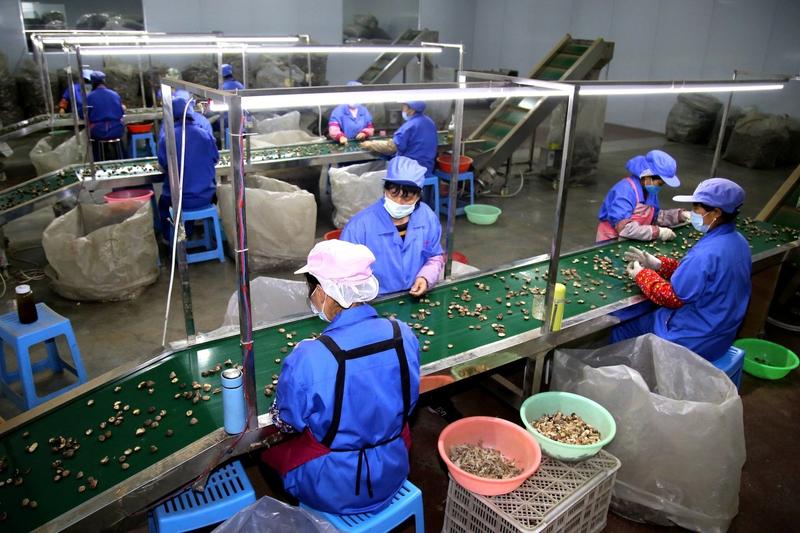 Quality control staff check button mushrooms at an agricultural products company in Shiyan, Hubei province. (PHOTO / XINHUA)
Quality control staff check button mushrooms at an agricultural products company in Shiyan, Hubei province. (PHOTO / XINHUA)
China has continued to improve the quality and efficiency of its financial sector by urging banking institutions to stabilize credit supply to micro and small-sized enterprises (MSEs) and increase support for the resumption of work and production of such businesses, as the novel coronavirus outbreak continues to wane across the country.
By the end of April, outstanding loans to small businesses with a total credit line of up to 10 million yuan (US$1.4 million) for each borrower amounted to 12.79 trillion yuan, rising by 27.34 percent since the end of April last year.
The average interest rate of new loans issued by 18 national commercial banks to MSEs was 4.94 percent, down 0.5 percentage point from last year, said the China Banking and Insurance Regulatory Commission.
The government should lead the design of special supply chain financing whose risks it can cover along with banks and enterprises. And the government, not banks, should shoulder the responsibility of implementing bailouts
Tang Dajie, Director of research with the Saiyi Enterprise Institute and a visiting research fellow at Wuhan University's Center of Finance and Law
ALSO READ: China's SMEs eye 'big' steps for smooth business operations
Earlier this month, the All-China Federation of Industry and Commerce announced the results of a survey on 150,000 MSEs and individually-owned businesses. The survey showed that about 20 percent of MSEs and individually-owned businesses are facing a cash flow crisis due to the pandemic.
Among small businesses with financing shortfalls, 73.7 percent require less than 500,000 yuan and 96 percent need less than 1 million yuan.
Since the pandemic broke out, among MSEs with financing needs but also realizing much smaller operating incomes than leading MSEs, over 40 percent have received loans without collateral from online-only banks.
The federation joined hands with MYbank, a privately owned online-only bank, and several other organizations in March to initiate a contactless lending program.
Joining the efforts of financial institutions and county-level governments, the program aims to give full support to about 10 million MSEs, individually-owned businesses and rural households nationwide within a half-year period to help them resume work and production in an orderly manner and expand production when the pandemic is fully contained.
The survey found that 70 percent of MSEs that received loans through the contactless lending program said the loans have effectively promoted business recovery.
The research institute of Ant Financial Services Group estimated that micro and small-sized business owners will realize a profit of about 2 yuan for each yuan of interest paid on these types of loans.
The China Banking Association said that by the end of April, the contactless lending program that targets MSEs had served over 10 million clients since the program recently began, and the total value of loans provided exceeded 400 billion yuan.
China's banking and insurance regulator also instructed banks to allow enterprises to use their accounts receivable, orders, warehouse receipts and inventories as collateral to secure funds through supply chain financing, which refers to systematic financing arrangements for the benefit of all members of a supply chain.
The regulator encouraged key enterprises in supply chains that received funding from banks to help reduce financial stress on upstream and downstream micro, small and medium-sized enterprises through measures such as paying in cash or making prepayments to suppliers.
By the end of April, banking institutions had offered key enterprises 22.4 trillion yuan to help them maintain capital flows and provided 17.4 trillion yuan of funding to their upstream and downstream enterprises.
READ MORE: SMEs’ business confidence hits rock bottom
"The government should lead the design of special supply chain financing whose risks it can cover along with banks and enterprises. And the government, not banks, should shoulder the responsibility of implementing bailouts," said Tang Dajie, director of research with the Saiyi Enterprise Institute and a visiting research fellow at Wuhan University's Center of Finance and Law.
Key enterprises, banks and the government could jointly form project teams. The enterprises will provide authentic information about their suppliers and clients, while banks will design and offer financial services after conducting risk assessments, and the government will provide guarantees to cover possible losses, Tang said.
In this way, banks will find the will to pump money into enterprises in upstream and downstream supply chains, especially micro, small and medium-sized enterprises, without worrying about hidden risks, he added.


